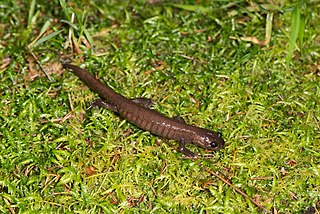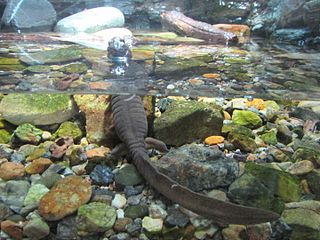Amji's salamander is a species of salamander in the family Hynobiidae. This species is endemic to China, or more specifically to Zhejiang Province; its breeding habitat consists of five small pools at the top of Mount Longwangshan, in Anji County, north-western Zhejiang, at about 1,300 m (4,300 ft) above sea level. Adult males have a total length of 153–166 mm (6.0–6.5 in) and females of about 166 mm (6.5 in).

Hynobius arisanensis, the Alishan salamander, is a species of salamander in the family Hynobiidae endemic to Taiwan. It occurs in the Alishan Range, the Yushan Range, and southern Central Mountain Range, where it lives at altitudes of 1,800–3,600 m (5,900–11,800 ft) above sea level. Its natural habitats are temperate forests, rivers, and freshwater springs. It is usually hiding during day time.
The Chinese salamander is a species of salamander in the family Hynobiidae endemic to China. Its natural habitats are subtropical or tropical moist lowland forests, rivers, freshwater marshes, freshwater springs, and arable land. It is threatened by habitat loss.

The Oita salamander is a species of salamander in the family Hynobiidae endemic to Japan. Named after Oita Prefecture, its natural habitats are temperate forests, rivers, intermittent rivers, freshwater marshes, intermittent freshwater marshes, and irrigated land in western Japan. It is threatened by habitat loss, due to the increasing construction of homes within its habitat. The Oita Salamander is considered to be vulnerable by the (IUCN) Red List of Threatened Species with a declining population.

Hynobius formosanus, the Taiwan salamander, is a species of salamander in the family Hynobiidae, endemic to Taiwan, where it occurs in the high mountains at around 2,100 m (6,900 ft). Its natural habitats are from open alpine habitats to shaded moist evergreen forests. Adults have a total length of 58–98 mm (2.3–3.9 in).
The Hakuba salamander or Japanese mountain salamander is a species of salamander in the family Hynobiidae. This salamander is also synonymous with the mountain salamander. It is endemic to Japan. Its natural habitats are temperate forests, rivers, swamps, freshwater springs, and plantations. It is threatened by habitat loss.
Hynobius katoi is a species of salamander in the family Hynobiidae, endemic to Japan. Its natural habitats are temperate forests and rivers.

The Tohoku salamander is a species of salamander in the family Hynobiidae, endemic to Japan. Its natural habitats are temperate forests and rivers.

Hynobius nebulosus, the Mitsjama salamander, is a species of salamander in the family Hynobiidae endemic to Japan. Its natural habitats are temperate forests, rivers, swamps, freshwater springs, and irrigated land. It is threatened by habitat loss.

The Japanese black salamander is a species of salamander in the family Hynobiidae, endemic to Japan.
The Oki salamander is a species of salamander in the family Hynobiidae, endemic to Japan. Its natural habitats are temperate forests, rivers, and plantations. It is threatened by habitat loss.

The Ezo salamander, also known as the Hokkaido salamander, Noboribetsu salamander, or Ezo Sanshouo in Japanese is a species of salamander in the family Hynobiidae. Prior to 1923 the species was also classified by the binomial scientific name Satobius retardatus. H. retardatus is endemic to Japan's northernmost prefecture, the island of Hokkaido. The species is a pond-type salamander, and its natural habitats are temperate forests, temperate shrubland, swamps, freshwater marshes, intermittent freshwater marshes, freshwater springs, irrigated land, canals, and ditches.
Hynobius sonani, the Taichu salamander, is a species of salamander in the family Hynobiidae, endemic to Taiwan, where it occurs in the Central Mountain Range above 2,750 m (9,020 ft). Its natural habitats are from open alpine habitats to shaded moist evergreen forests; it breeds in streams.
The amber salamander, amber-colored salamander, tortoiseshell salamander, or Stejneger's oriental salamander is a species of salamander in the family Hynobiidae, endemic to Japan. Its natural habitats are temperate forests and rivers. It is threatened by habitat loss.
The Hokuriku salamander is a species of salamander in the family Hynobiidae, endemic to Japan. Its natural habitats are temperate forests, rivers, freshwater marshes, freshwater springs, and irrigated land. It is threatened by habitat loss.

The Tokyo salamander is a species of salamander in the family Hynobiidae, endemic to Japan. Its natural habitats are temperate forests, freshwater springs, arable land, irrigated land, and canals and ditches. It is threatened by habitat loss. Many different species of amphibian have unbalanced sex ratios. This trend is no different in Hynobius Tokyoensis; the sex ratio between males and females is about 1.5:1. Although this does not play as large of a role as habitat destruction when it comes to the decline of this species, it is still significant. Considering their environmental preferences, they are usually found in paddy fields. Mid-Summer drainage from these fields hinders the population's ability to thrive as this would occur before these populations could complete metamorphosis.
The Tsushima salamander is a species of salamander in the family Hynobiidae, endemic to Japan. Its natural habitats are temperate forests and rivers.
Hynobius yiwuensis, the Yiwu salamander, is a species of salamander in the family Hynobiidae, endemic to Zhejiang, China. Its distribution area is central and eastern Zhejiang, and includes Yiwu that has given it its name. Its natural habitats are subtropical moist lowland forests, rivers, freshwater marshes, intermittent freshwater marshes, arable land, and rural gardens. The Yiwu salamander is threatened by habitat loss.
The Xingan salamander is a species of salamander in the family Hynobiidae, endemic to China: it is only known from its type locality, Mao'ershan in the Xing'an County, Guangxi. Its natural habitats are marshes and the surrounding forests. It is threatened by habitat loss and, living close to the summit of Mao'ershan at around 2,000 m (6,600 ft) asl, by climate change. It occurs within the Mao'ershan National Nature Reserve.









